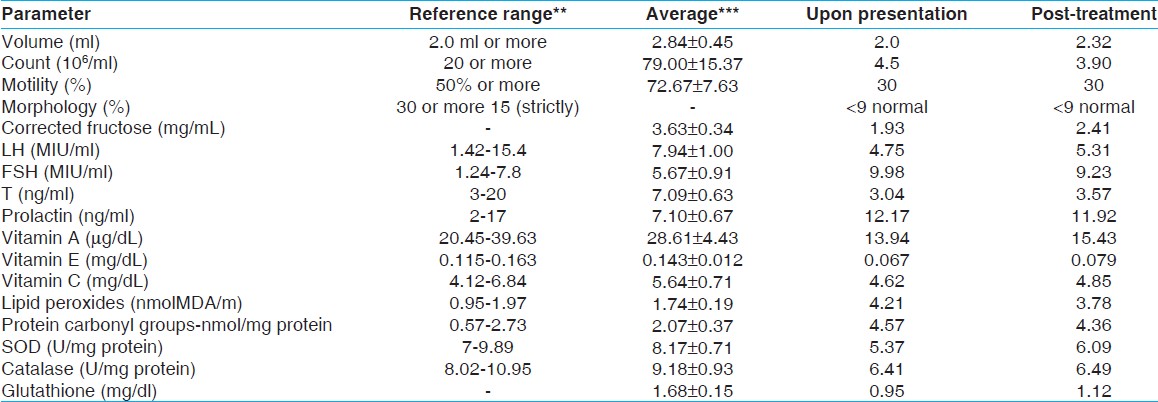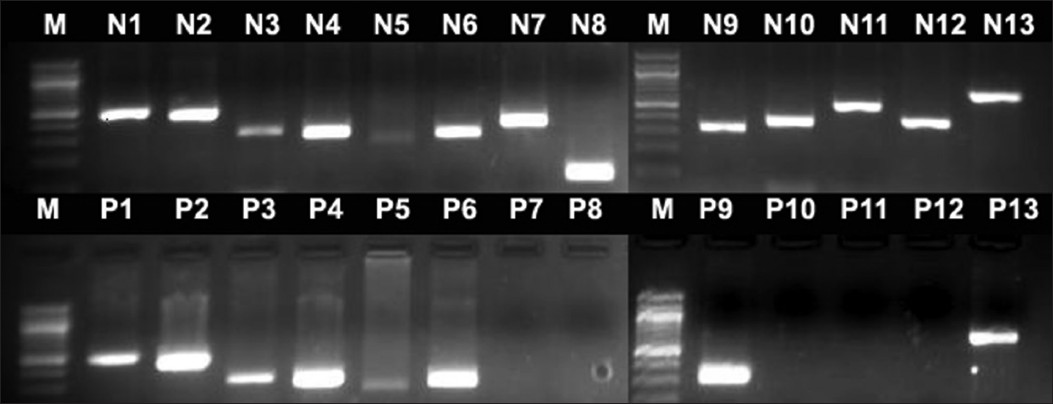|
 
 |
|
CASE REPORT |
|
|
|
| Year : 2012 | Volume
: 18
| Issue : 3 | Page : 359-362 |
| |
A case of oligoasthenoteratozoospermia with AZFc deletion and persistent oxidative stress
Rajender Singh1, Ahmad Mohammad Kaleem2, Sankhwar Satya Narayana3, Abbas Ali Mahdi2
1 Division of Endocrinology, Central Drug Research Institute, Lucknow, India
2 Department of Biochemistry, Chhatrapati Sahuji Maharaj Medical University, Lucknow, India
3 Department of Urology, Chhatrapati Sahuji Maharaj Medical University, Lucknow, India
| Date of Web Publication | 4-Mar-2013 |
Correspondence Address:
Rajender Singh
Division of Endocrinology, Central Drug Research Institute, Lucknow - 226 001, Uttar Pradesh
India
 Source of Support: Ministry of Health and Family Welfare (MOH and FW), Govt. of India,, Conflict of Interest: None  | 2 |
DOI: 10.4103/0971-6866.108037

 Abstract Abstract | | |
Y-chromosomal microdeletions are associated with severe oligozoospermia or azoospermia. AZFc microdeletions have been always associated with severe oligozoospermia or azoospermia with a rare occurrence in individuals with other infertility phenotypes. We report here a rare case of an infertile man carrying AZFc deletion, whose semen picture is oligoasthenoteratozoospermia complexed with seminal oxidative stress. Anti-oxidant therapy could make no change in either oxidative stress biomarker levels of semen, seminal parameters or serum hormone levels. Therefore, oligoasthenoteratozoospermia in the present case correlates with AZFc deletion, and high content of abnormal sperm eventually might be responsible for persistently elevated reactive oxygen species levels. Understanding the function of genes in AZFc region could help decipher the exact cause of the phenotype in such cases.
Keywords: AZFc deletion, male infertility, oligoasthenoteratozoospermia, oxidative stress
How to cite this article:
Singh R, Kaleem AM, Narayana SS, Mahdi AA. A case of oligoasthenoteratozoospermia with AZFc deletion and persistent oxidative stress. Indian J Hum Genet 2012;18:359-62 |
How to cite this URL:
Singh R, Kaleem AM, Narayana SS, Mahdi AA. A case of oligoasthenoteratozoospermia with AZFc deletion and persistent oxidative stress. Indian J Hum Genet [serial online] 2012 [cited 2016 Jun 1];18:359-62. Available from: http://www.ijhg.com/text.asp?2012/18/3/359/108037 |
 Introduction Introduction | |  |
Even though the exact function of most genes on the Y chromosome is still not known, the evidence suggest that they are directly involved in male fertility regulation. [1] The Y chromosome AZFc region deletions result in severe oligospermia or azoospermia. The candidate genes on AZFc region have testis specific expression; however, their exact role is still not known. [2] DAZ genes (major spermatogenic candidate on AZFc) encode proteins located in human late spermatids and in sperm tails, which suggests a function of DAZ proteins in the RNA metabolism of late spermatids, mostly the storage or transport of testis-specific mRNA, the translation of which is repressed until the formation of mature spermatozoa. Hence, deletion of DAZ genes was supposed not to interfere with sperm maturation but to result in a gradual reduction of mature spermatozoa. [3]
Oligo asthenoteratozoospermia (OAT) is a condition of abnormally low sperm count, motility, and high count of misformed spermatozoa in the ejaculate. Of all the OAT patients, approximately 30%, are diagnosed as idiopathic. OAT is rarely associated with Y chromosome microdeletion. [4] In the present study, we report a case of infertile man with a clinical picture of OAT associated with AZFc deletion and persistent elevated levels of reactive oxygen species (ROS) even after antioxidant therapy.
 Case Report Case Report | |  |
The patient was a 35-year-old man, presented with primary infertility of five years duration. The patient had no history of testicular injury, vericocele, torsion or hydrocele, cancer chemotherapy, and chronic infectious disease. Physical examination revealed normal vital signs with a BMI of 24.5 kg/m 2 , scrotally placed testis (32 ml total volume), bilaterally palpable vas deferens, and normal masculine habitus with no signs of gross abnormalities. The female had normal ovulatory cycle and normal hysterosalpingography (confirmed by ultrasound examination of the ovaries during the ovulatory phase and ovulatory progesterone plasma concentrations on day 21). Reproductive hormone tests revealed that the level of serum luteinizing hormone (LH), testosterone, and prolactin were within normal range, whereas the level of follicle-stimulating hormone (FSH) was slightly elevated [Table 1].  | Table 1: Laboratory test results showing patient's serum hormone levels and semen parameters
Click here to view |
Semen evaluation was conducted twice according to established protocols, separated by a three-week interval. Seminal plasma lipid peroxides, vitamins A, vitamin E, ascorbic acid, fructose, corrected fructose, total lipids, cholesterol, phospholipids, and triglycerides were measured as described elsewhere. [5] Values for sperm count, morphology, and motility were low [Table 1].Seminal plasma levels of lipid peroxides and protein carbonyl group (PCG) were elevated, whereas vitamin A, vitamin E, superoxide dismutase (SOD), and catalase were lower than the normal limit. The level of vitamin C was within normal limits [Table 1]. These findings were confirmed by a second set of tests performed on a different occasion. In view of these findings, a presumptive diagnosis of oligoteratoasthenozoospermia (OAT) associated with oxidative stress was made.
The patient was prescribed Anoxee supplement once-daily for a period of two months followed by Mucuna pruriens seeds powder at the dose of five gm/day orally for three months to alleviate the oxidative stress. We have earlier demonstrated effectiveness of M. pruriens in treatment of oxidative stress associated male infertility. [5]
At the end of therapy, the laboratory analyses were repeated [Table 1]. None of the parameters under investigation showed a desired improvement. Before deciding upon further treatment, molecular analyses of Y-chromosome were carried out according to the guidelines suggested by European Academy of Andrology (EAA). [6] The results revealed intact AZFa and AZFb, whereas AZFc was completely deleted [Figure 1]. Further analyses using another set of primers confirmed the b2/b4 deletion pattern of AZFc. The two markers sY254 and sY255 are specific to the DAZ (deleted in azoospermia) gene, which is normally present in four copies in AZFc region. [6] The analysis suggested that abnormal sperm production was associated with AZFc deletion.  | Figure 1: First row, lane 2-9, PCR products for STS markers sY84, sY86, sY127, sY134, sY254 and sY255, lane 11- 15, PCR products for STS markers sY116, sY1191, sY1291, sY1206 and sY1201, amplified from DNA of normal man. Second row, PCR products from patient DNA showing AZFc deletion and b2/b4 re-arrangement
Click here to view |
 Discussion Discussion | |  |
Several genetic causes of male infertility have been identified such as chromosomal abnormalities, Y-chromosome microdeletions, translocations, cystic fibrosis trans-membrane conductance regulator (CFTR) mutations, and other genetic factors. The deletion of AZFc region is most common Y chromosome abnormality, leading to severe oligozoospermia and azoospermia in 5-10% of infertility cases. [6] The above studies have suggested that AZFc deletion is largely associated with reduced sperm concentration (oligozoospermia and azoospermia) rather than structural deformity (teratozoospermia). Accordingly, no reports are available associating AZFc deletion with OAT and persistent oxidative stress. We report here the association between AZFc deletion and oligoasthenoteratozoospermia, which could possibly correlate with oxidative stress. Therefore, the genes in this region seem important not only for normal sperm count but also for normal sperm morphology.
The elevation in seminal oxidative stress may be due to non-spermatogenic factors like; genitor-urinary infections, vericocele, torsion, cryptorchidism, lifestyle factors (smoking, dietary deficiencies, excessive alcohol consumption, psychological stress, extremes of exercise activity or ageing), harmful environmental toxicants, chronic diseases (diabetes, kidney disease, hemoglobinopathies), and autoimmune disorders (reviewed in [7] ). The spermatogenic factors responsible for elevated oxidative stress are abnormal morphology, [8] reduced sperm motility, [9] and lower sperm count. [10] Abnormal sperm morphology was well-known cause of ROS generation, whereas low sperm count and motility have been reported only recently as sources of ROS. Since the patient had none of the former complications, the source of ROS in the present case is most likely the spermatozoa. Men carrying AZFc deletion can father child by assisted reproduction. However, the sons born will be carrying the deletion.
The identification of more diverse infertility phenotypes in the individuals carrying AZFc deletions makes it imperative to dissect out the function of the genes in this region of the chromosome. Identification of the genes and their function would help correlate the infertility phenotypes to genes with specific functions. This would help establish genotype-phenotype correlation and further understand the process of spermatogenesis. Rare case reports, such as the one presented here, may be the key to identification of spermatogenic genes, which contribute to infertility little less often.
 Acknowledgement Acknowledgement | |  |
The authors are thankful to Ministry of Health and Family Welfare (MOH & FW), Govt. of India, for financial support. Madhukar Dama was helpful in communicating with the patient and safekeeping the records.
 References References | |  |
| 1. | Vogt PH. Human chromosome deletions in Yq11, AZF candidate genes and male infertility: History and update. Mol Hum Reprod 1998;4:739-44. 
[PUBMED] |
| 2. | Yen PH. Putative biological functions of the DAZ family. Int J Androl 2004;27:125-9. 
[PUBMED] |
| 3. | Habermann B, Mi HF, Edelmann A, Bohring C, Bäckert IT, Kiesewetter F, et al. DAZ (Deleted in AZoospermia) genes encode proteins located in human late spermatids and in sperm tails. Hum Reprod 1998;13:363-9. 
|
| 4. | El Awady MK, El Shater SF, Ragaa E, Atef K, Shaheen IM, Megiud NA. Molecular study on Y chromosome microdeletions in Egyptian males with idiopathic infertility. Asian J Androl 2004;6:53-7. 
[PUBMED] |
| 5. | Ahmad MK, Mahdi AA, Shukla KK, Islam N, Jaiswar SP, Ahmad S. Effect of Mucuna pruriens on semen profile and biochemical parameters in seminal plasma of infertile men. Fertil Steril 2008;90:627-35. 
[PUBMED] |
| 6. | Simoni M, Bakker E, Krausz C. EAA/EMQN best practice guidelines for molecular diagnosis of y-chromosomal microdeletions. State of the art 2004. Int J Androl 2004;27:240-9. 
[PUBMED] |
| 7. | Tremellen K. Oxidative stress and male infertility-a clinical perspective. Hum Reprod Update 2008;14:243-58. 
[PUBMED] |
| 8. | Said TM, Agarwal A, Sharma RK, Thomas AJ Jr, Sikka SC. Impact of sperm morphology on DNA damage caused by oxidative stress induced by beta-nicotinamide adenine dinucleotide phosphate. Fertil Steril 2005;83:95-103. 
[PUBMED] |
| 9. | Kao SH, Chao HT, Chen HW, Hwang TI, Liao TL, Wei YH. Increase of oxidative stress in human sperm with lower motility. Fertil Steril 2008;89:1183-90. 
[PUBMED] |
| 10. | Pasqualotto FF, Sharma RK, Pasqualotto EB, Agarwal A. Poor semen quality and ROS-TAC scores in patients with idiopathic infertility. Urol Int 2008;81:263-70. 
[PUBMED] |
[Figure 1]
[Table 1]
| This article has been cited by | | 1 |
Efficacy of tamoxifen andl-carnitine on sperm ultrastructure and seminal oxidative stress in patients with idiopathic oligoasthenoteratozoospermia |
|
| E. A. Nada,M. A. El Taieb,H. M. Ibrahim,A. E.-R. A. Al Saied | | Andrologia. 2014; : n/a | | [Pubmed] | [DOI] | |
|
 |
|






